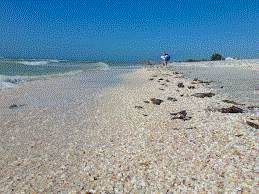 |
Increase in Tourism Impacts Seashell Loss
Walking down the beach you see the perfect shell. You pick it up, put it in your pocket and decide to keep it to remind you of your trip to paradise. While different agencies, states and countries have specific regulations on taking shells, vials of sand, or any other object from its natural environment, you are generally not allowed to bring these souvenirs home with you, especially to another country.

Why? Mainly because if everyone did it, there would be none left. But despite airports seizing tons of shells each week, seashells are still disappearing at various tourist locations and according to a new study, as global tourism increases, human-induced seashell loss may harm natural habitats worldwide.
A new study conducted by researchers from the Florida Museum of Natural History on the University of Florida campus and the University of Barcelona demonstrates that increased tourism on the Mediterranean coast of Spain correlated with a 70% decrease in mollusk shells during the tourist season in July and August and a 60% decrease in other months.

Scientists fear shell removal could cause significant damage to natural ecosystems and organisms that rely on shells, said lead author Michal Kowalewski, the Thompson Chair of Invertebrate Paleontology at the Florida Museum. How? For one, shells provide a home or attachment surface for organisms like algae, seagrass and sponges. Hermit crabs also use shells as protective armor while some fish use these shells to hide from predators. In addition, shells are mostly made of calcium carbonate and in many coastal habitats they dissolve slowly and recycle back into the ocean.
In the study, researchers conducted multiple monthly surveys from 1978 to 1981 and from 2008 to 2010 on Llarga Beach, a small stretch of shoreline on the coast of Spain. Based on area hotel sales data, researchers estimate the number of tourists visiting the beach increased threefold over the last 30 years, with most visits during the summer. Over the same time period, the number of shells on the beach decreased by more than 60%. The survey area has experienced no new commercial fisheries or urban development since the 1970s, suggesting human activity unrelated to tourism is unlikely to have contributed substantially to the shell loss, Kowalewski said. Changes in ecosystem structure and local environmental conditions, which could potentially contribute to a natural decrease in shell numbers, were not observed, he said.
Winter, Allison, Increase in Tourism Impacts Seashell Loss, ENN, January 9, 2014
To learn more about GHA
and how your property can be greener,
jump to Green Hotels Association!
or CALL 713/789-8889 TODAY!
|

GREEN TRAVEL IDEAS!
 "Further ideas for greener individual travel," says Patricia Griffin, include: during your hotel stay, let management know that it is not necessary to change your towels and sheets every day. When you leave the room, turn off the AC/heat, lights and TV. Leave the little bottles of shampoo, if you don't use them. Take used bar soap home with you. Avoid room service.
"Further ideas for greener individual travel," says Patricia Griffin, include: during your hotel stay, let management know that it is not necessary to change your towels and sheets every day. When you leave the room, turn off the AC/heat, lights and TV. Leave the little bottles of shampoo, if you don't use them. Take used bar soap home with you. Avoid room service.







|
 |


